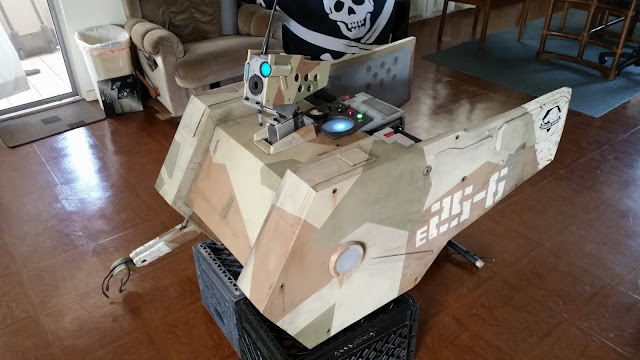I had wanted to make this style of costume for a long time. About 3 years ago, I was sketching plans for a Megaman X2 ride armor costume. The mech's arms and legs would be mine, I would wear a Megaman helmet, and a little pair of puppet arms would appear to be controlling the mech.
Then MGSV trailers started showing up, and I recognized that D-Walker would be a much easier and more appropriately designed candidate for this project. Then I started my Snake arm project and MGSV came out, and I'm only barely exaggerating when I say I spent Q4 of 2015 doing nothing else. I burnt out on the arm project and didn't make anything for a couple months. Eventually I heard about Amazing Hawaii Comic Con coming in June, and I remembered D-Walker. I envisioned an ultra-simple build, but as I dug deeper into my junk bins, it got more and more complicated.
From April to June 19th I devoted most of my time to D-Walker. Below is the final assembly before the con. It's about 3 hours condensed into 3 minutes.
Somewhere in the middle of that I add some red vinyl and weathering to the side panels, then glue the middle section to the handlebars. This helps bring the middle pieces together and seals up a large gap near the grips. This also makes the middle panels the only foam that is no longer removable - the side panels are still attached with zip ties only.
On the way to the convention in a Scion xB with a couple inches to spare.
The prize was a huge, hammerhead shark-themed great axe. I couldn't even carry it and operate DW at the same time. It is now displayed on the wall of my wife's burger shop Burgers and Things, which also has tons of other cool comic and video game art donated by their adoring customers.
The bad ass Shredder won last year's contest, but he had to wait until the con came back this year to collect his prize.
The most rewarding aspects of making this costume was not winning the costume contest or showing it off or even admiring the finished product. For me, the process was the most enjoyable stage. Digging through my bins and finding old scraps of plastic and metal takes me back to when I played with Legos in the exact same way. No matter how mundane an item's history, for some reason my brain has a section devoted to cataloging them. I know when the perfect piece is hiding at the bottom of the bin, stashed away years ago, before its specific value was apparent.
D-Walker is a culmination of finding purpose for such items, and in a way, working on it was like tying off loose mental strings. At any given time I can look at myself a year or even a month ago and chuckle at how naive I was, at the odd decisions I made, at how much I have learned since then. But whenever I uncover a scrap of metal that I saved from ending up in a landfill some years ago, my seemingly irrational behavior back then is justified. I can reach back in time and commend myself for saving the skeletal remains of a cheap inkjet printer, because by some stroke of resourceful thinking and/or luck, today those remains are exactly what I needed. It's kind of like a manageable form of hoarding - I squirrel away this or that just in case I need it some day, just because it may have some conceivable value to someone somewhere sometime. But a collection needs to be organized and inventoried, or it stops being an asset and becomes a burden. And unlike a serious hoarding disorder, those loose ends I had collected were eventually utilized.
Productively liquidating a collection of garbage is a good feeling, especially while building a cool robot costume from one of my favorite video game series, and all at relatively small expense. After I finished D-Walker, I gave away the rest of my junk to other crafters, in hopes it would be useful to them too. I was still left with some stuff that no one wanted, and I was a little remiss to trash it. It was still just a bunch of junk though, some of which I have actually shipped from Hawaii to Oregon to Hawaii once before. When I move back to Oregon with my wife next year, I want to start with a clean slate. At least until I have a bunch of empty, easily accessible and labeled storage bins set up in a garage workshop - then I can start scavenging Craigslist free ads and roadside garbage again!
Thanks for reading! I hope it was helpful and/or interesting. Now go build something!
































